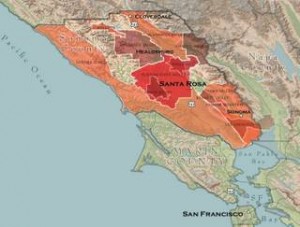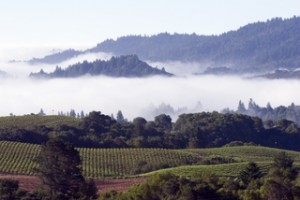Sonoma strikes for coolness
Sonoma, in California, made its cool climate case at a recent seminar in London, showing mostly pinot noirs with two chardonnays, a couple of classic grape varieties associated with cool climate viticulture.
Panellists for the seminar were:
Rod Berglund, owner and winemaker at Joseph Swan Winery.
Tom Hinde, president and director of winemaking at Flowers Vineyard and Winery.
Jeff Stewart, winemaker at Buena Vista.

Sonoma County Wine Regions
The definition of cool climate mentioned was Winkler’s Region I, and Stewart said: “we’re cool climate guys so we’ll always reference Burgundy.”
Honore Comfort, executive director of Sonoma County Vintners, the organisation that promotes Sonoma County wines, introduced the session. “Sixty miles of Pacific Ocean front influence the daily climate of Sonoma County.”
It is this oceanic influence that provides the defining model for Sonoma viticulture. Deep, cold ocean currents offshore provide a regular supply of cold air above the ocean. On a daily basis, during the afternoon, this chill air is drawn inland, as fog, by the hot Sacramento Valley. Comfort said: “the cool maritime fog defines the region: how it filters in through the Petaluma Gap, up the Russian River, and into Carneros from the bay to blanket the county,” adding the fog blanket stays in Sonoma, blocked by the Mayacamas ranges on the eastern edge of the county.

Sonoma fog blanket
The major effect of these daily fogs, which come in practically like clockwork, is cooling. Hinde said: “on the coast during the day it’s 85°F [30°C], at night it’s 35°F [2°C]. At Healdsburg [in the middle of the county], it’s 95°F [35°C] in the day and 60°F [16°C] at night. Typically there’s a 25 to 30°F [14 to 17°C] diurnal shift.”
As well as a cool overall climate, vintage variation is a parameter for cooler climate, and whilst it’s not a big issue for Sonoma, it clearly exists. Hinde said “nine years out of ten we have a consistent climate, a Mediterranean climate, with a long wet winter, and an arid summer. And within this we have the influence of the Pacific Ocean.”
However, in Russian River Valley, Berglund said “I see different personalities, different expressions [in the wines]. We do see vintage variation in Russian River Valley, some are more fruit forward, some have more structure and backbone, such as the ’07s. But we don’t see the wide variations, for example in Oregon.”

L-R: Comfort, Stewart, Hinde, Berglund
Stewart added “2004 was a very early bud-break and season. It was forward, giving wines that were beautiful straight out of the gate. 2005 was later, cooler, giving wines with more structure; not the structured wines of the ‘07s which were built for the long haul.”
The moderating influence of this coastal phenomenon is evidently the main influence enabling grape varieties such as pinot noir and chardonnay to be grown, though more than 60 varieties are grown in the county, including hot-climate loving zinfandel.
Alongside coolness, soil is often considered another primary factor for quality, but the panellists could come up with few acceptable generalisations about the area. It is, after all, an active fault zone, so topography and soils are by definition enormously complex, with the gamut of volcanic, sedimentary and alluvial deposits closely intermingled. Aspect and slope are similarly something of a patchwork effect.
The wines tasted originated from three of the coolest AVAs in Sonoma County: Carneros, Russian River Valley and Sonoma Coast.
Tasting Notes, March 2010, London
The contradiction of high alcohol and so-called cooler climate is a hard one for a European to overcome.
La Crema Chardonnay 2008, Sonoma Coast (13.9%)
Hinde: “not an estate but a Sonoma Coast blended wine. It’s representative of the potential for chardonnay here. Eight to nine months in oak, around 20% new, including some American oak.”
Ripe, peachy and mealy nose, spicy aromatic oak, vanilla and charcoal, heat of alcohol a little too evident, heating the back of the palate. Sweet praline nuttiness, quite full bodied, very warming palate with some attractive typical flavour characters, but back palate is too hot for me and wine broadens in the glass.
Ramey Wine Cellars, Ritchie Vineyard Chardonnay 2006, Russian River Valley (14.5%)
Sweet smoke, high glycerol, slippery texture, with almost overt honeyed sweetness at the fore of the palate. Full bodied, with overt alcohol reasonably well integrated. Almond-toasted lemon cake, with allspice and star anise aromatic spices. Length not massive. Full-fat, lush fruit, good concentration of fruit, heat coming through on the end.
Stewart: “the first two pinot noirs both come from Carneros AVA (American Viticultural Area), which is fruit driven, with cherry, berry, and always an earthiness, a forest floor, more than in Russian River Valley.”
Gloria Ferrer Caves and Vineyards, Pinot Noir 2007, Carneros (13.9%)
Translucent ruby colour with bright red-cherry nose and smoked charcoal note. Oak a little raw on the palate attack, black and tarry without redeeming elegance. Spicy, smoked forest berry fruits, with alcohol present but not dominant and wood tannins a little edgy. Tarry note blows off in time, but leaves the finish a bit dry and talc-like.
Buena Vista Carneros Pinot Noir 2007, Carneros (13.5%)
Stewart: “we hand harvest at night, then have a 5 to 10 day cold soak. Average 17 days on the skins; 30-35% new French oak with a 10 to 11 months’ ageing regime.”
Translucent ruby, aromatic strawberry and raspberry nose. Smooth, sweet palate attack, sweet fruit, attractive varietal definition, with balance of fruit and acid core, and tannins held neatly at bay for aromatic focus. Balanced and integrated. Very nice; with long finish. Crunchy freshness emphasises aromatic fruitiness well. Nicely balanced.
Flowers Vineyard and Winery, Andreen Gale Pinot Noir 2007, Sonoma Coast (13.5%)
Hinde “we’re still discovering where pinot noir and chardonnay will do their best. We believe we’re challenging the outer [cooler] margin for pinot noir and chardonnay.” The winery is 1 mile from the Pacific at 500 to 700m ASL.
Medium translucent ruby. Nose a bit elusive, but simple crunchy red cherries are there. Palate has appropriate grip of supporting oak tannin, beginning to soften. In crunchy rather than soft style, perky acid freshness keeps the palate linear, with enough fruit flesh to comfortably balance the structure. Not a fleshy wine, hint tomato leaf? Medium full body, alcohol integrated, unnoticed. Decent finish.
Patz and Hall Pinot Noir 2007, Sonoma Coast (14.2%)
Medium translucent red cherry. Lifted red cherry and red apple notes on the nose. Fresh palate attack, soft aromatic tar supporting very ripe sweet black and red cherries. Some lushness to palate with good acid frame. Good varietal definition. Alcohol integrated. Oak just enough to soften in. Balanced, full and sweet. Good, with lengthy finish.
Berglund: “the final two: textural element. RRV has wonderful texture and mouthfeel. We have more red fruit characters with hints of cola. Carneros wines tend to me more linear, while RRV is broader on the palate. Sonoma Coast wines have darker fruits than RRV. The Hobbs wine has more dark fruits. Our wine comes from one of oldest pinot noir vineyards, planted in 1969.”
Joseph Swan Vineyards, Trenton Estate Vineyard Pinot Noir 2007, Russian River Valley (14.5%)
Medium cherry red. Lifted cherry, with fine-grainy spicy oak and gently mulled fruit to the fore; texture of stewed fruit, with sandalwood, and cinnamon oak notes, not (yet?) melding together. A bit disjointed at the moment, with dry sandy sides to palate. Feels like a ‘cooler’ expression, but the alcohol is evident. Alcohol expressed as those warm stewed fruits, but it doesn’t burn. Fruit is fresh and dense, with good concentration. I’m sure it’ll come through, there’s nice fruit underneath. It’s rich and dense and not over-ripe.
Paul Hobbs Pinot Noir 2007, Russian River Valley (14.7%)
Medium ruby colour. Bright dark cherry fruit, sweet, full-fleshed and lush. With good pinot noir character: firm acid core supporting fleshy cherry fruit. Sweet balance, with alcohol unnoticed and integrated. Lush and delicious. More-ish.



